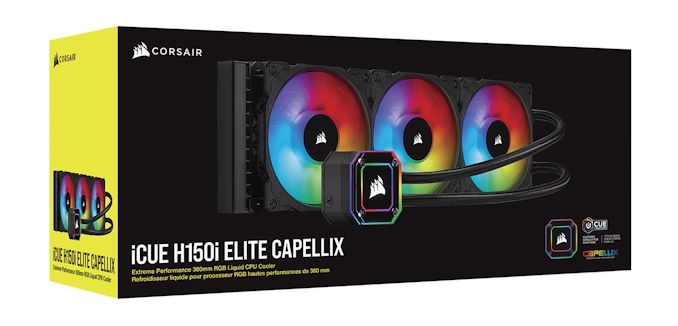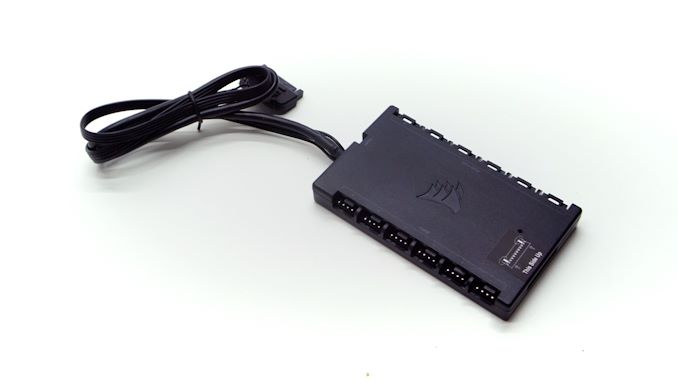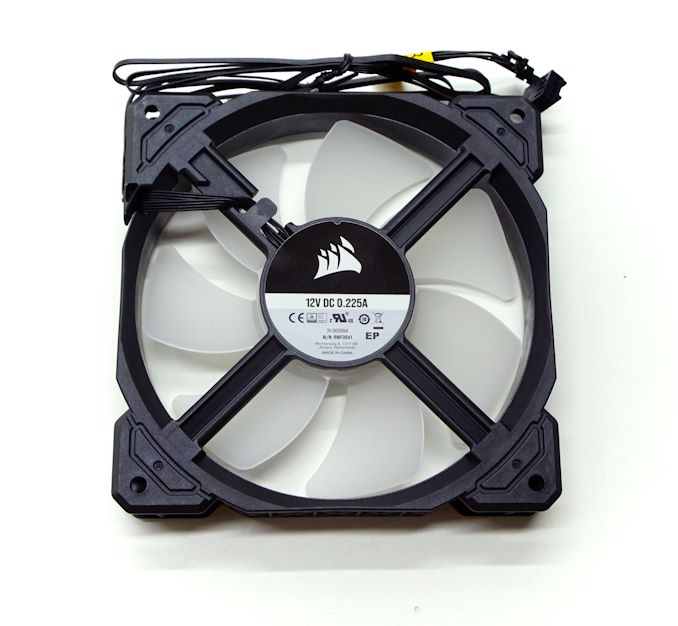The Corsair H150i Elite Capellix AIO Cooler Review: Go Big Or Go Home
by E. Fylladitakis on October 15, 2020 9:30 AM EST- Posted in
- Cases/Cooling/PSUs
- Corsair
- Water Cooling
- Liquid Cooling
- RGB
- iCUE

Corsair is one of the oldest and most reputable PC component manufacturers in the PC market. The company’s origins lie with memory-related products but, nearly two decades ago, the company slowly began diversifying into other segments of the market. While their initial attempts were reluctant, releasing but a couple of products each time, most of these attempts were highly successful and drove the company to grow massively into the entrepreneurial (and recently IPOed) giant that they are today.
These days, one of Corsair’s most successful product segments is that of all-in-one (AIO) liquid coolers – an ironic outcome considering that liquid coolers were the company’s first unsuccessful diversification attempt back in 2003. Corsair did not give up on liquid cooling though and several years later, when simple and maintenance-free AIO cooler designs appeared, Corsair successfully launched their own AIO coolers. Today, AIO coolers are one of Corsair’s most popular group of products, with the company retailing over a dozen different models at this point of time.
In this review we're taking a look at our first cooler from Corsair's new Elite Capellix series of AIO coolers, the H150i Elite Capellix. Like previous H150 AIO coolers, this is a 360mm (3x120mm) cooler, the largest that Corsair makes and ostensibly offering the best cooling performance thanks to its hefty radiator size. For cases that can fit the sizable cooler, the H150 series typically addresses both end of the performance spectrum, offering modest cooling at very low fan speeds (and thus noise levels), or top-tier cooling at more normal fan speeds.
For their new Elite Capellix generation of coolers, Corsair has given their product lineup another layer of polish. Along with incorporating the latest and greatest from Corsair in terms of MagLev fans and pump heads, Corsair has focused on making the Elite Capellix series “Smart” AIO coolers, adding an advanced Commander CORE module into the bundle. A combination fan and RGB lighting controller, the Commander CORE greatly enhances the programming flexibility of the cooler’s performance and lighting features, allowing it to control fans and lighting throughout an entire system.
Packaging & Bundle
We received the new H150i Elite Capellix in a long cardboard box, hinting the size of the cooler. Corsair is currently shipping most of their products in artistically similar black/yellow themed packaging and this cooler is no exception. A colorful picture of the H150i covers the relatively simple front of the packaging. Inside the box we found the cooler and its parts well protected by custom cardboard inserts.
As expected, Corsair includes all of the necessary mounting hardware into the box. The H150i Elite Capellix supports most of the current consumer CPU sockets, including sTR4/sTRX4 for AMD Threadripper CPUs, the mounting hardware for which are also included in the bundle. Corsair also includes an alternative main block cover for aesthetic purposes.
Corsair supplies a Commander CORE module alongside with the H150i Elite Capellix, which essentially is a version of the iCUE Commander Pro RGB controller that the company retails as a stand-alone product, simply tailored to control the RGB lighting of the liquid cooler instead. Nevertheless, it sports six fan power and RGB LED connectors, allowing users to install up to three additional compatible fans, enabling either push-pull configurations or the control of system fans.
The included three ML120 fans feature cutting edge magnetic levitation engines, with their specifications suggesting extraordinary longevity. Unlike all classic designs, these engines magnetically repel the fan’s rotor, greatly reducing friction. Lower friction should lead to significantly superior overall performance and longevity, as well as lower energy consumption, which explains the low current requirement for the rated speed of 2400 RPM. The fans have frosted blades and a black frame, with eight RGB LEDs each.















37 Comments
View All Comments
SirMaster - Sunday, October 25, 2020 - link
I mean my air cooled PC fans are never faster than 800rpm. I can't even tell if it's on or off from a few feet away.khanikun - Sunday, October 18, 2020 - link
A whisper is around 30 db. NZXT Kraken X63 280mm in reviews is around 30 db at low. So I'd say that's whisper quiet.willis936 - Thursday, October 15, 2020 - link
Not even Corsair's marketing speaks so highly about these fans. Magnetic bearings are not "magnetic levitation engines" (that would be the motor, which all fans have) and they are not new.They're awesome and they're cool to see in case fans, but the 1st page words leave a bad taste.
https://en.wikipedia.org/wiki/Magnetic_bearing
https://www.corsair.com/corsairmedia/sys_master/pr...
E.Fyll - Thursday, October 15, 2020 - link
From my point of view, the magnetic bearing is but a part of the engine that converts electrical energy to mechanical energy (airflow). You are probably referring to the engine as just the part that converts electrical energy to torque, neglecting the rest of the transmission system, which is not wrong but I would rather keep things simpler than that in my texts. I always classify fan engines based on their movement transmission system because everything else remains pretty much the same. You will find terms such as "ball-bearing engine" and "sleeve-bearing engine" frequently in my texts. The term "magnetic levitation engine" may not be entirely technically correct but definitely is better than "a 12V DC brushless motor with a magnetic levitation bearing axial transmission system" for the average person.Magnetic bearings may not be new by technological terms but they are just finding applications in low-cost retail market products, hence they are cutting-edge by the applicable definition of the term. There are many technologies that find their way into the retail market many decades after their initial discovery - that does not make them archaic, it only means that the conditions made their commercial exploitation applicable.
willis936 - Thursday, October 15, 2020 - link
These are fair points. Thanks for taking the time to respond.Pneumothorax - Thursday, October 15, 2020 - link
I’m currently running a NH-D15 on a 9900K. Am I getting any improvement with this besides just the aesthetics?Drkrieger01 - Thursday, October 15, 2020 - link
No. You'll may actually lose cooling capacity, as Linus found out (Linus Tech Tips). He did a review showing that big heatsinks like the Noctua NH-D15 outperform pretty much all AIO water coolers when it comes to heat soak (when the heatsink/radiator hit their dissipation limits). Granted, the margin is only a few degrees, but still. What you will get with an AIO water cooler is a slower increase/decrease in temperatures as the water works as an absorbing/transfer medium. The more water in the loop, the longer it takes to bring up the temperatures.Drkrieger01 - Thursday, October 15, 2020 - link
I should also say that, if AIO coolers would actually use a copper radiator, they would outperform something like the NH-D15. None of the AIO's use copper in their radiator, and I believe this is due to a patent being held by the main AIO manufacturer.imaheadcase - Thursday, October 15, 2020 - link
I don't think that would matter though, it still follows tubing back to the CPU, that itself is terrible at temp retention. Especially when they make them long on purpose for all case types they installed in.But yah i found its to much of a hassle to go all out with stuff like this, really AIO coolers for me now are just about looking better and working better in case for airflow than actual performance.
imaheadcase - Thursday, October 15, 2020 - link
on side note pet peeve, for whatever reason EVERY AIO cooler i have bought has never fit correctly in a case i've had..despite it showing it should before i bought it. Its mostly cosmetic things to change, like bending a small piece of metal, or something you won't notice with case cover on. But last one was a pain because after everything was installed in complete new build..it wouldn't power on. So did the normal check everything is connected, yep. I ended up finding out that radiator actually cut the USB cable connection front of case next to power button. So it was shorting out, all i had to do was unplug usb and booted up fine.That litte stupid problem would of been avoided if had correct specs..that was like 2 hours of trouble shooting. lol